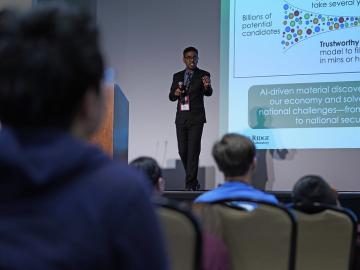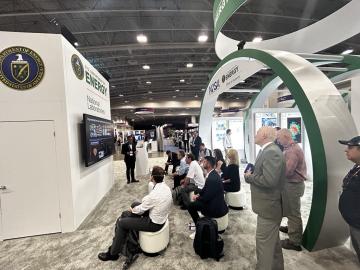
Filter News
Area of Research
- Biological Systems (1)
- Biology and Environment (25)
- Clean Energy (73)
- Computational Biology (2)
- Computational Engineering (1)
- Computer Science (7)
- Electricity and Smart Grid (2)
- Fusion and Fission (3)
- Isotopes (4)
- Materials (20)
- Materials for Computing (6)
- National Security (12)
- Neutron Science (14)
- Nuclear Science and Technology (1)
- Quantum information Science (7)
- Sensors and Controls (1)
- Supercomputing (45)
- Transportation Systems (2)
News Type
News Topics
- (-) Artificial Intelligence (61)
- (-) Biomedical (40)
- (-) Grid (46)
- (-) Mercury (10)
- (-) Quantum Science (40)
- (-) Transportation (62)
- 3-D Printing/Advanced Manufacturing (73)
- Advanced Reactors (21)
- Big Data (44)
- Bioenergy (67)
- Biology (78)
- Biotechnology (15)
- Buildings (39)
- Chemical Sciences (36)
- Clean Water (27)
- Climate Change (72)
- Composites (17)
- Computer Science (127)
- Coronavirus (28)
- Critical Materials (16)
- Cybersecurity (17)
- Decarbonization (55)
- Education (1)
- Emergency (2)
- Energy Storage (60)
- Environment (148)
- Exascale Computing (28)
- Fossil Energy (5)
- Frontier (26)
- Fusion (40)
- High-Performance Computing (56)
- Hydropower (11)
- Irradiation (2)
- Isotopes (32)
- ITER (5)
- Machine Learning (33)
- Materials (78)
- Materials Science (80)
- Mathematics (9)
- Microelectronics (2)
- Microscopy (31)
- Molten Salt (6)
- Nanotechnology (28)
- National Security (42)
- Net Zero (10)
- Neutron Science (74)
- Nuclear Energy (74)
- Partnerships (20)
- Physics (34)
- Polymers (17)
- Quantum Computing (25)
- Renewable Energy (1)
- Security (12)
- Simulation (39)
- Software (1)
- Space Exploration (22)
- Statistics (2)
- Summit (37)
- Sustainable Energy (92)
- Transformational Challenge Reactor (3)
Media Contacts

Two ORNL teams recently completed Cohort 18 of Energy I-Corps, an immersive two-month training program where the scientists define their technology’s value propositions, conduct stakeholder discovery interviews and develop viable market pathways.

Power companies and electric grid developers turn to simulation tools as they attempt to understand how modern equipment will be affected by rapidly unfolding events in a complex grid.

Researchers at the Department of Energy’s Oak Ridge National Laboratory and partner institutions have launched a project to develop an innovative suite of tools that will employ machine learning algorithms for more effective cybersecurity analysis of the U.S. power grid.

Brian Sanders is focused on impactful, multidisciplinary science at Oak Ridge National Laboratory, developing solutions for everything from improved imaging of plant-microbe interactions that influence ecosystem health to advancing new treatments for cancer and viral infections.

Researchers at Oak Ridge National Laboratory have opened a new virtual library where visitors can check out waveforms instead of books. So far, more than 350 users worldwide have utilized the library, which provides vital understanding of an increasingly complex grid.

Researchers used quantum simulations to obtain new insights into the nature of neutrinos — the mysterious subatomic particles that abound throughout the universe — and their role in the deaths of massive stars.
Close on the heels of its fourth summer school, the Quantum Science Center, or QSC, hosted its second in-person all-hands meeting in early May. More than 150 scientists, engineers and support staff traveled from 17 institutions to review the QSC’s progress, examine existing priorities and brainstorm new short- and long-term research endeavors.

Prasanna Balaprakash, a national leader in artificial intelligence, or AI, spoke to some of the highest achieving students in the country at the National Science Bowl in Washington D.C.

Purdue University hosted more than 100 attendees at the fourth annual Quantum Science Center summer school. Students and early-career members of the QSC —headquartered at ORNL — participated in lectures, hands-on workshops, poster sessions and panel discussions alongside colleagues from other DOE National Quantum Information Science Research Centers.

ORNL researchers and communications specialists took part in the inaugural AI Expo for National Competitiveness in Washington D.C, May 7 and 8, to showcase and provide insight into how the lab is leading the way for utilizing the vast possibilities of AI.


